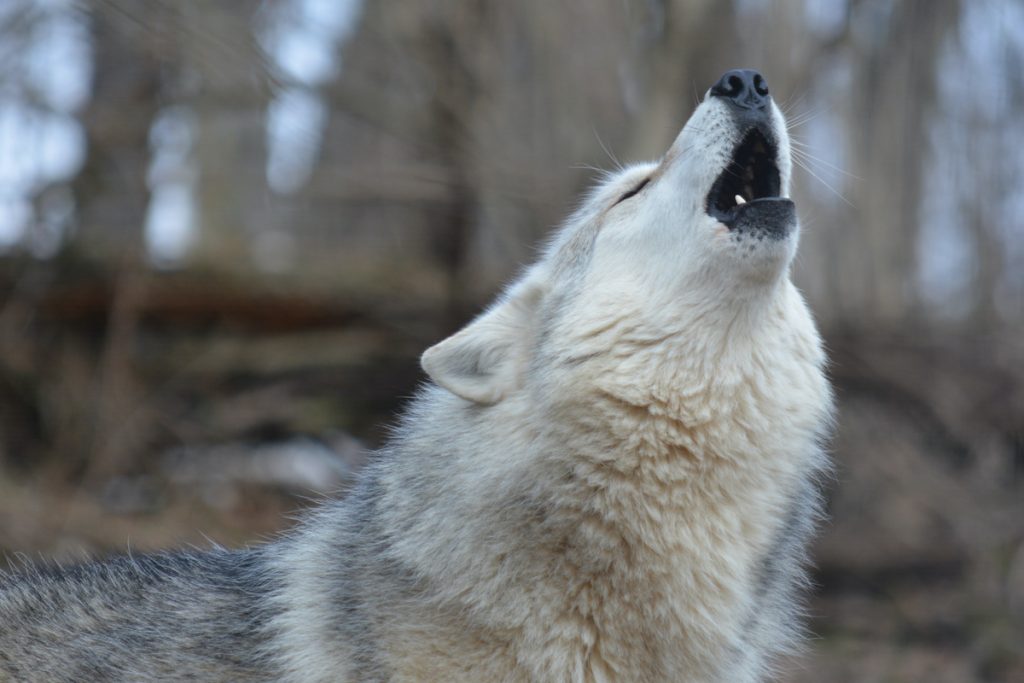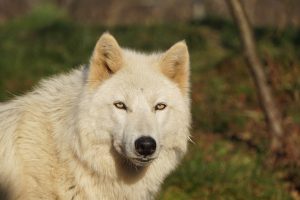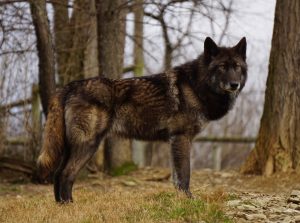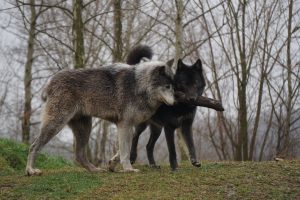Running with Wolves
Heed the call of the wild in Lititz

Hundreds of years ago, before the arrival of Europeans, the forests of Pennsylvania were home to wolves. They were the apex predator, preying on large mammals like deer, elk and bison. As settlers moved in, wolves’ food sources dwindled, and they resorted to eating livestock and farm animals. This, along with their valuable pelts, made them the target of trappers, hunters and the government. By the mid-20th century, wolves were nearly extirpated (locally extinct) in the contiguous United States.
The last wild wolf in Pennsylvania is recorded to have died in 1892. Today, the only place in the state to see wolves living outdoors is the Wolf Sanctuary of PA in Lititz. For over 40 years, the sanctuary has provided a home for wolves and wolfdogs (domestic dog/wolf hybrid) in need. About an hour and 15 minutes from West Chester, the sanctuary is worth a visit this month and beyond — after all, Wolf Awareness Week is October 20–26.
The Gray Wolf

The wolves you’ll see at the sanctuary are gray wolves, or Canis lupis. The gray wolf is the most common wolf species on Earth, with an estimated 200,000 to 250,000 worldwide. Other wolf species include the Ethiopian wolf, only found in the mountains of Ethiopia, and the red wolf, which was reintroduced to the southeastern U.S. starting in the 1980s — though taxonomists debate whether red wolves are a distinct species, subspecies of gray wolf or coywolf (coyote/wolf hybrid).
In the U.S., gray wolves were first added to the Endangered Species list in 1974. Conservation efforts since then, including their reintroduction to Yellowstone National Park in 1995, have led to a resurgence in the gray wolf population. Today, there are as many as 18,000 wild gray wolves in the U.S., two-thirds of which live in Alaska. The rest are found in the Midwest and West.
Despite the name, gray wolves’ fur color ranges from gray, tan and brown to pure black or white. They’re 4.5 to 6.5 feet long and 26 to 32 inches tall. Females weigh between 55 and 100 pounds, males between 70 and 145. They have powerful jaws, which can exert 1,500 pounds of pressure per square inch — twice as much as a German shepherd — and crush bones in just a few bites. When chasing prey, they can reach top speeds over 35 miles per hour.
Gray wolves are social animals that live and hunt in packs. Wolf packs are comprised of a breeding pair — they typically mate for life — and their offspring. Packs can have as few as two or as many as 30 members, with an average of six to eight. In the Alaskan wilderness, a pack’s territory ranges from 300 to 1,000 square miles, while in the rest of the country, territories can be as small as 50 square miles. Wolves communicate through vocalization (howling, growling, barking), body language (eye contact, facial expressions, tail position) and scent marking. They can live up to 13 years in the wild, though the average lifespan is only 6 to 8 years, and up to 16 years in captivity.
Wolves are considered a “keystone species,” meaning their presence greatly impacts the surrounding ecosystem. As the apex predator, wolves keep large mammal populations (like deer) in check. Without wolves, coyotes try to fill the niche, but since they primarily hunt mid-size and small prey, nature falls out of balance. Wolves’ impact can be felt in places like Yellowstone, where wolf repopulation has led to a revitalization of the ecosystem and populations of several species, from birds of prey to trout, have increased.
The Wolf Sanctuary
Situated in the heart of Pennsylvania Dutch country, the Wolf Sanctuary of PA is a refuge for gray wolves and wolfdogs. The sanctuary rescues animals from across the country, including cases of illegal ownership, abuse and retired zoo animals.

“The sanctuary was founded by the Darlington family in 1980 out of a love of wolves,” said Michelle Mancini, the sanctuary’s Education Coordinator. In the ’70s, Bill and Barbara Darlington began caring for wolves on their property, the historic Speedwell Forge. When Pennsylvania made it illegal to own wolves or wolfdogs without a license and permit, the Darlingtons were granted a menagerie permit by the PA Game Commission. “As animals were confiscated from elsewhere, calls started coming in with rescue requests,” said Mancini. And thus, the Wolf Sanctuary of PA was born.
Today, over 50 wolves and wolfdogs live within the sanctuary’s 80+ wooded acres, each with a unique personality and life story. This includes Halona, who hails from Iowa. Skinny and weak, she was discovered tethered in a dark barn. The family who found Halona took her in, but they sought a better life for her once it became clear she wasn’t thriving in a home environment. Today, she loves to romp and play with her packmate, Isabelle.

While the sanctuary’s primary focus is rescuing wolves, its secondary mission is educating the public. “We want to reframe the narrative around wolves. They’ve been plagued by misinformation for centuries, which affects their conservation status,” Mancini said.
The sanctuary aims to dispel these myths. “First and foremost, wolves aren’t the fairytale monsters that the media makes them out to be. They’re actually very shy — their instinct is to avoid people and things that are unfamiliar to them,” said Mancini. “On the other side of the spectrum, people believe that wolves are like domestic dogs, but they’re not the same. They don’t belong in the household, no matter how cute and cuddly they look.”
In short, the sanctuary plays an important role in the protection of a very vulnerable species. “We give wolves a place to live out their lives in a respectful environment,” Mancini said. “There were hardly any wolves left in the country at the start of the 20th century. Without places to conserve and educate, we would backslide again.”
As the sanctuary’s motto puts it, “Extinct is Forever.”
Visiting the Sanctuary
Ready to see and learn about the wolves? The Wolf Sanctuary of PA is open year-round for public and private guided tours. During your tour, you’ll encounter several of the wolves who call the sanctuary home, learning about their lives and unique personalities along the way. Public tours are 60 to 90 minutes long, with groups of around 30, while private tours last about two hours. Advanced booking is required for all tours.
Wolves prefer cold weather, so you may want to plan your visit on a chilly day. “We encourage people to visit during a snowy, cold winter day,” said Mancini. “That said, it’s cool to see how their coats adapt to the seasons, shedding in spring and bulking up in winter.”

Additionally, the Wolf Sanctuary hosts events throughout the year. Every month, they host Full Moon Fundraisers on the Saturday closest to the full moon — up next is the Hunter’s Moon, October 19. Enjoy a roaring bonfire, live entertainment and tour the sanctuary by moonlight. (Note: this is the sanctuary’s only age-restricted event, and visitors must be 16 or older.)
Or bring the whole family to celebrate Wolf Awareness Day on October 26. This kid-friendly event features self-guided wolf tours — as always, the wolves stay behind tall fences, no petting or touching allowed — plus pumpkin painting, educational games and activities, live music, food trucks and more.
Visiting the sanctuary is a great way to learn about a fascinating yet misunderstood creature while supporting their conservation. And, if you fall in love with a certain wolf, you can further support them through a symbolic adoption.
“We are a nonprofit. We don’t have large grant funding at this time, so we really rely on donations and people visiting to keep providing homes for the wolves and wolfdogs in our care,” Mancini explained. “We get requests for rescues all the time. Without places like us, there’s nowhere for them to go.”
IF YOU GO
What: Wolf Sanctuary of PA
Where: 465 Speedwell Forge Rd., Lititz
Tour Information: WolfSanctuaryPA.org
